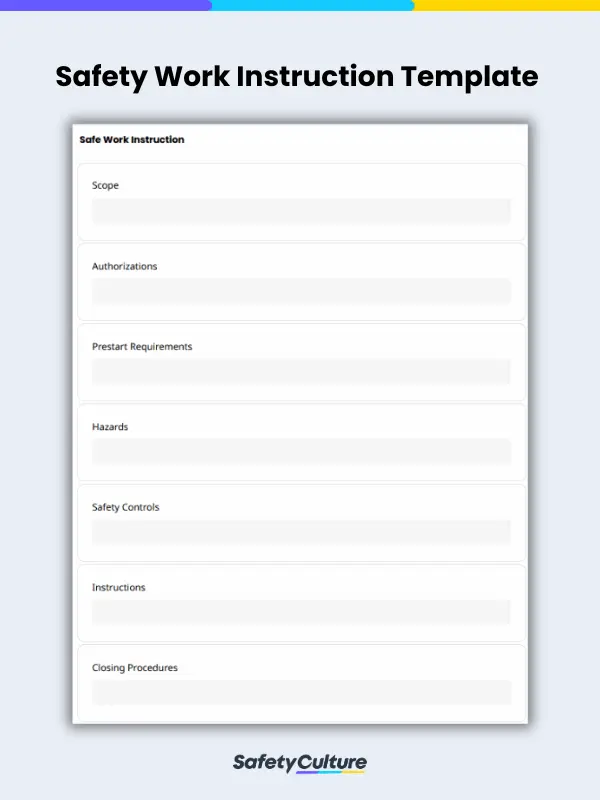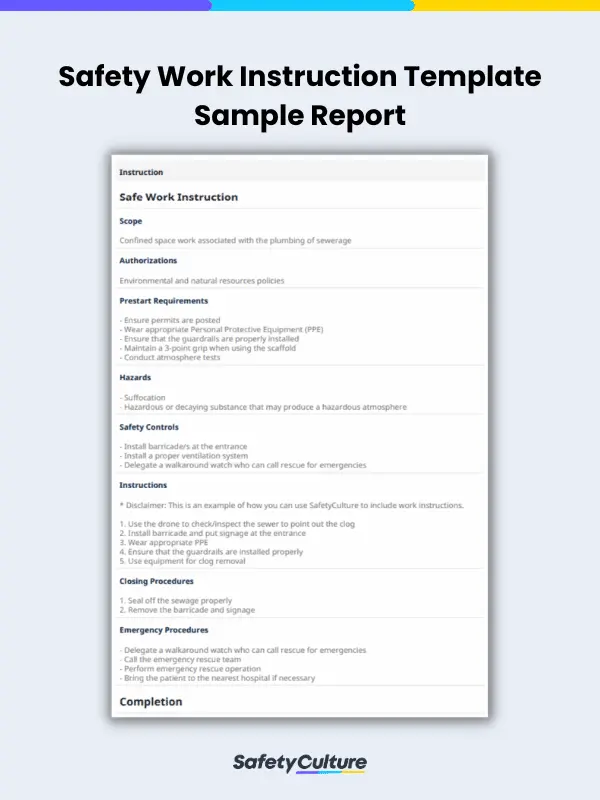What is a Work Instruction Template?
A work instruction template, also known as a job instruction template, is a tool used to demonstrate specific, sequential, and detailed information on who, what, when, and how a certain task is going to be performed. It provides guidance that is ideal for newly hired employees to quickly get involved in the workforce and production backup. Also, it helps reduce the likelihood of risks and errors when executing work processes, ensuring standardized operations.
What is the Purpose of a Work Instruction Template?
A work instruction template is essential to businesses in various industries, providing a clear roadmap for achieving specific tasks and projects. It serves as a comprehensive guide to the team in performing certain tasks including the step-by-step processes, project requirements, tools, materials to be used, and other policies that will help them perform their task accurately. It also helps boost employee efficiency and productivity, among its other benefits:
Error Reduction
One of the core objectives of a work instruction template is to reduce errors and improve the accuracy of task execution. By clearly defining each step, along with relevant safety precautions and quality standards, these templates help employees avoid mistakes in doing their jobs and produce reliable outcomes.
Training and Onboarding
Work instruction templates offer a comprehensive guide that simplifies the learning process, enabling newcomers to quickly grasp the necessary procedures and carry out tasks effectively. This is especially helpful in industries with complex or safety-sensitive processes, including construction, food manufacturing, and oil and gas production.
Regulatory Compliance
In sectors subject to regulatory oversight, such as healthcare, manufacturing, and aerospace, work instruction templates aid in achieving and demonstrating compliance. They document the procedures and safety measures required by regulators, ensuring that an organization follows established standards.
Knowledge Retention and Transfer
Work instruction templates help capture the expertise of experienced employees, making it available for future reference. This knowledge transfer is vital for preserving best practices and ensuring operational continuity, even when experienced employees leave the organization.
What to Include in This Template
Creating a template for work instructions can help standardize the format and content of these documents within your organization. In most cases, a digital work instruction template must include the following elements and sections:
- Title Page – activity or task description, document number, initial issue date, current version, and next review date
- Work Instructions – activity’s scope, authorizations, pre-start requirements, hazards involved, safety controls, closing procedures, and emergency procedures
- Completion Page – creator/author sign-off
How to Write a Work Instruction Using a Template
Writing work instructions is crucial as it’s one of the foundations of a project. The person who will create work instructions should be well-informed, trained, and oriented about the subject matter. This is because a work instruction should be easy to comprehend, clear, and precise for every team member or stakeholder who will read and understand it as their reference.
To guide you, follow these steps to write work instructions using a template:
1. Provide general information.
Gather all the necessary information prior to constructing the work instruction, including the high-level procedures, policies, and task dependencies. Note that it’s important to provide the context of the project or task assigned. Also, give an overview of the purpose of the job and identify the project or task owners.
2. Present a step-by-step procedure.
State clear and simple details of the project on how it should be done. It should be easy to understand and can be followed immediately to ensure that every action is carried out by the task owners. It should also include the materials, references, or visuals to support the work instructions, as needed.
3. Validate the task.
Work instructions should be written by Subject-Matter Experts (SMEs) to ensure that every detail of the instruction is accurate and within the scope of work. Utilize the template’s sections to accurately document each detail.
4. Keep it simple.
Work instructions should be user-friendly and formatted for easy reading. It should be in sequential order and refrain from using complex words such as jargon (unless highly necessary), acronyms, and technical terms that can’t be understood by the intended user. Make sure to use appropriate language and keep the work instructions short and concise.
5. Test the instructions.
Let a colleague follow the steps. Identify if there’s any confusion or unclear instructions that would lead to improper processing of the task. Doing this would help to immediately correct the work instruction template prior to dissemination to the task owners.
6. Keep it documented.
Record the work instructions on a template and distribute the exported templates as reports or reference documents to task owners. Ensure they read and validate it prior to task execution. Also, review the work instructions regularly and update them if necessary. Lastly, save it so that anyone who may need it can access it.
Work Instruction Template Example
Whether you’re seeking to create or improve your own work instruction templates, achieve your objectives with greater efficiency and precision using this work instruction template example as a valuable reference point:
FAQs About Work Instruction Templates
Work instruction templates are often a component of Standard Operating Procedures (SOPs). SOPs provide a broader framework for how an organization operates, while work instructions offer specific guidance for individual tasks within those procedures.
Work instruction templates are an invaluable tool for documenting and improving complex or multistep processes. They promote consistency, accuracy, and the retention of critical knowledge, making them an essential resource in a variety of industries where intricate procedures are part of everyday operations.
Work instructions created using templates help address non-conformance concerns, standardize processes, and ensure documentation control. This then helps organizations establish and maintain Quality Management Systems (QMS) in compliance with International Organization for Standardization (ISO) standards, among others.




